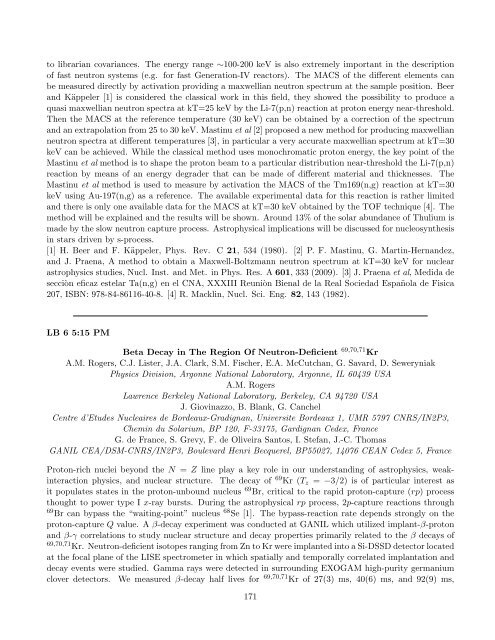Program - Brookhaven National Laboratory
Program - Brookhaven National Laboratory
Program - Brookhaven National Laboratory
Create successful ePaper yourself
Turn your PDF publications into a flip-book with our unique Google optimized e-Paper software.
to librarian covariances. The energy range ∼100-200 keV is also extremely important in the description<br />
of fast neutron systems (e.g. for fast Generation-IV reactors). The MACS of the different elements can<br />
be measured directly by activation providing a maxwellian neutron spectrum at the sample position. Beer<br />
and Käppeler [1] is considered the classical work in this field, they showed the possibility to produce a<br />
quasi maxwellian neutron spectra at kT=25 keV by the Li-7(p,n) reaction at proton energy near-threshold.<br />
Then the MACS at the reference temperature (30 keV) can be obtained by a correction of the spectrum<br />
and an extrapolation from 25 to 30 keV. Mastinu et al [2] proposed a new method for producing maxwellian<br />
neutron spectra at different temperatures [3], in particular a very accurate maxwellian spectrum at kT=30<br />
keV can be achieved. While the classical method uses monochromatic proton energy, the key point of the<br />
Mastinu et al method is to shape the proton beam to a particular distribution near-threshold the Li-7(p,n)<br />
reaction by means of an energy degrader that can be made of different material and thicknesses. The<br />
Mastinu et al method is used to measure by activation the MACS of the Tm169(n,g) reaction at kT=30<br />
keV using Au-197(n,g) as a reference. The available experimental data for this reaction is rather limited<br />
and there is only one available data for the MACS at kT=30 keV obtained by the TOF technique [4]. The<br />
method will be explained and the results will be shown. Around 13% of the solar abundance of Thulium is<br />
made by the slow neutron capture process. Astrophysical implications will be discussed for nucleosynthesis<br />
in stars driven by s-process.<br />
[1] H. Beer and F. Käppeler, Phys. Rev. C 21, 534 (1980). [2] P. F. Mastinu, G. Martin-Hernandez,<br />
and J. Praena, A method to obtain a Maxwell-Boltzmann neutron spectrum at kT=30 keV for nuclear<br />
astrophysics studies, Nucl. Inst. and Met. in Phys. Res. A 601, 333 (2009). [3] J. Praena et al, Medida de<br />
secciòn eficaz estelar Ta(n,g) en el CNA, XXXIII Reuniòn Bienal de la Real Sociedad Española de Fisica<br />
207, ISBN: 978-84-86116-40-8. [4] R. Macklin, Nucl. Sci. Eng. 82, 143 (1982).<br />
LB 6 5:15 PM<br />
Beta Decay in The Region Of Neutron-Deficient 69,70,71 Kr<br />
A.M. Rogers, C.J. Lister, J.A. Clark, S.M. Fischer, E.A. McCutchan, G. Savard, D. Seweryniak<br />
Physics Division, Argonne <strong>National</strong> <strong>Laboratory</strong>, Argonne, IL 60439 USA<br />
A.M. Rogers<br />
Lawrence Berkeley <strong>National</strong> <strong>Laboratory</strong>, Berkeley, CA 94720 USA<br />
J. Giovinazzo, B. Blank, G. Canchel<br />
Centre d’Etudes Nucleaires de Bordeaux-Gradignan, Universite Bordeaux 1, UMR 5797 CNRS/IN2P3,<br />
Chemin du Solarium, BP 120, F-33175, Gardignan Cedex, France<br />
G. de France, S. Grevy, F. de Oliveira Santos, I. Stefan, J.-C. Thomas<br />
GANIL CEA/DSM-CNRS/IN2P3, Boulevard Henri Becquerel, BP55027, 14076 CEAN Cedex 5, France<br />
Proton-rich nuclei beyond the N = Z line play a key role in our understanding of astrophysics, weakinteraction<br />
physics, and nuclear structure. The decay of 69 Kr (Tz = −3/2) is of particular interest as<br />
it populates states in the proton-unbound nucleus 69 Br, critical to the rapid proton-capture (rp) process<br />
thought to power type I x-ray bursts. During the astrophysical rp process, 2p-capture reactions through<br />
69 Br can bypass the “waiting-point” nucleus 68 Se [1]. The bypass-reaction rate depends strongly on the<br />
proton-capture Q value. A β-decay experiment was conducted at GANIL which utilized implant-β-proton<br />
and β-γ correlations to study nuclear structure and decay properties primarily related to the β decays of<br />
69,70,71 Kr. Neutron-deficient isotopes ranging from Zn to Kr were implanted into a Si-DSSD detector located<br />
at the focal plane of the LISE spectrometer in which spatially and temporally correlated implantation and<br />
decay events were studied. Gamma rays were detected in surrounding EXOGAM high-purity germanium<br />
clover detectors. We measured β-decay half lives for 69,70,71 Kr of 27(3) ms, 40(6) ms, and 92(9) ms,<br />
171
















